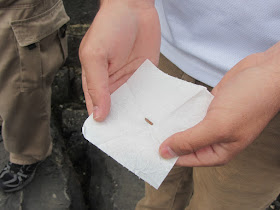Tomorrow is Palm Sunday, when most of Christendom commemorates Jesus’ Triumphal Entry into Jerusalem. Tomorrow also begins Holy Week, the commemoration of the final days of our Lord’s mortal life, culminating in his suffering, death, and resurrection. We have a wonderful opportunity while we are here in the Holy City to study and reflect upon the pivotal events of our faith while we are where they occurred. For years I have looked forward to being here to experience this.
Each day I will making posts, reflecting on the scriptural texts for each day and posting pictures and even video clips of the traditional sites in and around the city where these sacred events are believed to have occurred.
Wishing you and yours a a reflective Holy Week and a blessed, joyous Easter,
Eric Huntsman
 |
| View towards the Basilica of the Agony and the area of Gethsemane |
 |
| Gordon's Calvary, a Protestant alternative for Golgotha near the Garden Tomb |
 |
| The Holy Sepulchre, the traditional site of the crucifixion and resurrection |
 |
| African pilgrims throng the Garden Tomb |
 Last year I produced a book-length study of the Passion and Resurrection Narratives, God So Loved the World: The Final Days of the Savior’s Life, and LDS Living had me write a brief article on using the events of this week as part of our celebration of Easter. From them I have drawn the chronology that appears below. It includes a list of scripture readings and even musical selections for each day that can be used in personal and family study and reflection during this week. As the week progresses, I am adding links to each day so readers can go directly to blog posts about experiences on these days here in Jerusalem
Last year I produced a book-length study of the Passion and Resurrection Narratives, God So Loved the World: The Final Days of the Savior’s Life, and LDS Living had me write a brief article on using the events of this week as part of our celebration of Easter. From them I have drawn the chronology that appears below. It includes a list of scripture readings and even musical selections for each day that can be used in personal and family study and reflection during this week. As the week progresses, I am adding links to each day so readers can go directly to blog posts about experiences on these days here in Jerusalem
A Chronology of the Final Days of the Savior’s Life
Friday or Saturday
|
The anointing described by John (John 12:1–11).
|
Triumphal Entry; cleansing of the temple (Matthew 21:1–17; Mark: 11:1–11; Luke 19:28–46; John 12:12–19). Suggested Music: Sing “All Glory, Laud, and Honor.” Blessing of Palms and procession St. George Anglican Cathedral (10:30 a.m., 20 Nablus Road); Palm Sunday processional from Bethphage to St. Anne’s Church (2:30 p.m.)
| |
Cursing of the fig tree; cleansing of the temple in Mark; teaching in the temple (Matthew 21:18–22:14; Mark 11:12–19; Luke 19:47–20:18; John 12:20–36). Suggested Music: Sing “Come, O Thou King of Kings.” Go up on the Temple Mount (no scriptures or hymnbooks) and/or sit somewhere on the Mount of Olives or on a Jerusalem Center terrace where you can read Jesus’ teachings in the temple while you view the Haram.
| |
Lessons from the fig tree; more teachings in the; the Olivet Discourse (Matthew 22:15–25:46; Mark 11:20–13:37; Luke 20:19–21:38; John 12:37–50). Suggested Music: “Jehovah, Lord of Heaven and Earth.” Go to the Orson Hyde Memorial Gardens (in a large group) or the Pater Noster Church to read, sing, and view the city as Christ would have when he delivered the Olivet Discourse.
| |
Plot to kill Jesus; the anointing described by Mark and Matthew; Judas agrees to betray Jesus (Matthew 26:1–16; Mark 14:1–11; Luke 22:1–6). Suggested Music: “O Love That Glorifies the Son.” Bethany is not an easy option, so find another site on the Mount of Olives to remember the last day that Jesus spent with his friends, taking time in particular to recount the anointing of the unnamed woman and what it represents.
| |
The Last Supper; Gethsemane; betrayal and arrest; Jesus before the Jewish authorities (Matthew 26:17–26:75; Mark 14:12–72; Luke 22:7–71; John 13:1–18:27). Suggested Music: Listen Bach’s St. Matthew Passion; sing “Reverently and Meekly Now.” Go to the Garden of Gethsemane during the day, perhaps visit St. Peter’s in Gallicantu (site of Jesus’ hearing before Caiaphas) and the Cenacle (traditional Last Supper site). Students should not be in the Old City or East Jerusalem after dark.
| |
Jesus in the hands of the Romans; the Crucifixion; the burial (Matthew 27:1–61; Mark 15:1–47; Luke 23:1–56; John 18:28–19:42). Suggested Music: Listen to Bach’s St. John Passion; sing “O Savior, Thou Who Wearest a Crown” and “Behold the Great Redeemer Die.” Join the Via Dolorosa Way of the Cross procession (starting at 11:30 a.m. at the First Station down from Lion’s Gate); attend the Good Friday Service at Christ Church (1:00 p.m. inside Jaffa Gate across from the Citadel); go to the Garden Tomb to contemplate the Burial.
| |
Jesus in the Spirit World (Matthew 27:62–66; 3 Nephi 9–10; 1 Peter 3:18–4:6; D&C 138). Suggested Music: Listen to Wilberg’s Reqieum or Cundick’s Redeemer; sing “Turn Your Hearts.”
| |
The Resurrection (Matthew 28:1–15; Mark 16:1–14; Luke 24:1–49; John 20:1–23). Suggested Music: Listen to Handel’s Messiah; sing “Christ the Lord is Risen Today.” Attend the Easter Sunrise Service in the garden of the German Archaeological Institute-Auguste Victoria Compound (5:30 a.m., on Mount Scopus behind the center), the Sunrise Resurrection Services at the Garden Tomb (6:30 and 9:30 a.m.) or the Solemn High Mass at Notre Dame of Jerusalem (10:00 a.m., opposite New Gate).
|





























































